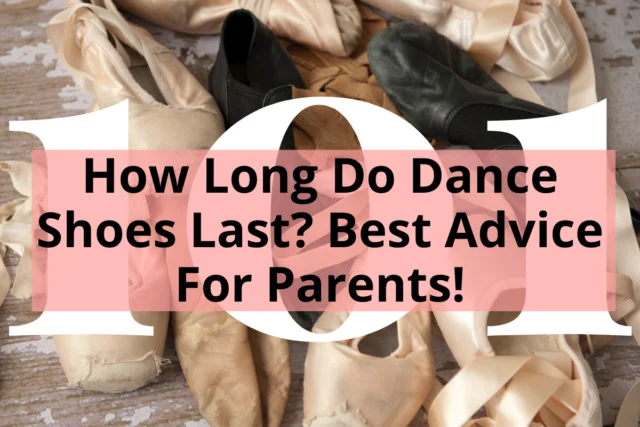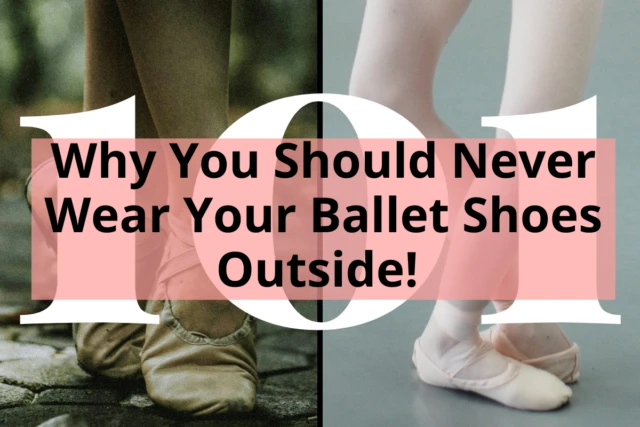By Lesley Mealor / Edited by Samantha Bellerose, B.Ed, Dip.Dance (Performing Arts)
If your child has ever been mesmerized by “The Descendants” or won’t stop singing along to “Hamilton”, chances are you’ve got a musical theatre fan on your hands! Whether they want to be the next big star or just want to dive deeper into the wonderful world of musicals, signing your kiddo up for a musical theatre dance class might be on your mind!
Musical theatre dance classes last between 45 minutes to an hour, and the focus is on storytelling and characterization. In theatre dance classes, the music will be from stage musicals or movie musicals. Multiple dance techniques are used and sometimes singing is incorporated.

Sometimes called Broadway jazz or theatre dance, these classes offer your child the best of many worlds, and they may even learn some history in the process – there are musicals about just about every subject, from Greek mythology (hello “Hadestown”) to Shakespeare (“Something Rotten”) to cats (well….”Cats”).
- Why Choose Musical Theatre Dance?
- How Old Does My Child Have To Be To Start Taking Musical Theatre Dance?
- How is Musical Theatre Dance Class Different From Other Dance Classes?
- Is There Singing in a Musical Theatre Dance Class?
- How is A Musical Theatre Class Structured?
- What Steps Should My Child Be Learning in a Beginner Theatre Dance Class?
- What Shoes Should My Child Wear to Musical Theatre Class?
- What Clothing Should My Child Wear to Theatre Dance Class?
- What To Expect In Other Dance Classes…
Why Choose Musical Theatre Dance?
Musical theatre dance is an excellent choice if you have a child who is interested in more than just dance. With theatre dance training, students are exposed to a variety of dance styles, music styles, acting methods, and sometimes even vocal training.
The premise behind musical theatre, in general, is that the characters within the show are so caught up in expressing themselves that they simply have to break into song and dance – regular speech is not enough to convey the emotion behind the story. If your dancer is expressive and emotional, they will fit right in in the musical theatre dance world.
Another reason you might choose Broadway dance is if your child wants to participate in school or community theatre productions.
Having a musical theatre specific dance background will give them a leg up on the competition when auditioning for musicals, because often, community participants have stronger vocal or acting training rather than dance training, and your child may stand out if they have been dancing for longer than others.
How Old Does My Child Have To Be To Start Taking Musical Theatre Dance?
Many dance studios or theatre programs with dance classes will allow students as young as 5 to begin musical theatre dance.
The goal in theatre dance is not necessarily to have amazing technique, so prior training in other dance forms is not required. So, beginner students can step into a musical theatre class with no problem.
How is Musical Theatre Dance Class Different From Other Dance Classes?
The main difference between musical theatre dance class and other dance classes is that the dancers will primarily be dancing to songs from Broadway or movie musicals.
The choreography in class and for recitals or shows will be specific to a storyline that already exists in a musical, or will be a storyline made up by the choreographer to a song that fits into the world of musical theatre.
Depending on the venue, theatre dance will be either very similar to other dance classes, or very different! If you are in a traditional dance studio setting, musical theatre class will likely look similar to a jazz class.
You will find that the class will warm up, learn some technical steps, go across the floor, and learn combinations, just like a jazz class, but there will be more emphasis on storytelling and characterization.
If you are at a community theatre program or professional theatre program that offers a musical theatre dance class, you may find that the emphasis is more on combining dancing with singing and acting.
In this type of class, part of the class may be focused on dance, and part of the class may be focused on vocal or acting exercises.
In musical theatre classes in general, there may also be an emphasis on learning about certain eras of musical theatre history so the students can better understand the context of the shows they are working on.
There may also be homework assigned, like watching Youtube clips of shows or researching famous musical theatre dancers from history.
Is There Singing in a Musical Theatre Dance Class?

There is sometimes singing in a musical theatre dance class!
Although important to the musical theatre genre, the inclusion of singing will depend on the kind of program you choose for your child to attend. Vocals and singing mostly happen in theatre-based programs, as not all dance studio-based programs are able to accommodate both the teaching of singing and dance.
However, being able to sing is a great skill to have if your dancer wants to pursue musical theatre as a profession or even a hobby or interest!
Just like your child is taking dance lessons, learning to sing technically well takes time, and therefore Investing in vocal lessons outside of their theatre dance classes should probably be thought about.
This is because unless your theatre dance teacher is also a trained singer on top of being a trained dance teacher, what your child will be learning from them can be limited, which brings us to our next point!
Sometimes, dancers will learn how to lip-sync over the music in a musical theatre routine, although this practice is a controversial topic in the dance studio world. Lip syncing in musical theatre dance is very popular in some parts of the world, but very unpopular in others!
The reason for the divide about lip-syncing is that some schools of thought believe that since dancers in real musicals are actually singing, lip syncing is like cheating.
Other schools of thought believe that it’s a good thing to learn how to lip-sync because it helps the dancer find their character.
The “jury” is hopelessly deadlocked on this debate, so when choosing your musical theatre dance class, find out what the teacher does and decide for yourself!
How is A Musical Theatre Class Structured?
A typical musical theatre or Broadway dance class in a dance studio setting lasts from 45 minutes to an hour. Class will begin with a warm-up, normally to music from a musical. The warm-up will consist of jazz-based techniques, with some stretching, cardio, and strengthening exercises as well.
After warm-up, dancers will move across the floor with basic, jazz-based exercises like walks, chassés, triplets, and jumps. The focus of these exercises will be timing, musicality, and showmanship.
Then, the students may learn a combination to a song from a musical. Depending on the theme of the month, or the theme of the class, they may learn something from a more current musical or something from a classic musical.
The style of the combination will be determined by the show the music is from. For example, a “Hamilton” combination will be more hip-hop based, while a combination from “Oklahoma!” will include more ballet and folk styles.
If the class includes vocal training, that part of the lesson may be incorporated into the beginning or end of the class.
What Steps Should My Child Be Learning in a Beginner Theatre Dance Class?
Musical theatre dance relies heavily on jazz and ballet techniques, although you will also find hip hop, contemporary, and tap techniques depending on the musical. For a general theatre dance class, though, dancers will be learning mostly jazz-based steps. Here is a short, non-exhaustive list of steps that beginner musical theatre dancers should be learning in class!
Chassé
Chassé means to chase, where one foot chases the other. Chassés can be done on one side only, or alternating sides.
Jazz Square
A jazz square or box step is a traditional musical theatre jazz step, and involves stepping in a box pattern with your feet.
Lindy
A lindy is simply a side-traveling chassé with a ball change or rock back tagged onto the end. A lindy is a traditional musical theatre step.
Grapevine
A grapevine is a traditional musical theatre step that travels side to side, with feet stepping to the side, crossing behind, stepping to the side, and touching together.
Passé Sauté
A passé saute is a hop that takes off from one foot while the other lifts up into passé. You land on the same foot you took off from. Passé sautés are often done right after a chassé for a dynamic traveling sequence.
Tuck Jump
Tuck jumps are performed by doing a passé sauté, but right after takeoff, pull the standing leg up as well, “tucking” both legs into a tight position beneath the body. Tuck jumps are often done right after a chassé.
Pivot
Pivot turns are simple turns that allow you to “about face” and change direction.
Three Step Turn
Three-step turns are simple turns that travel side to side and include three steps. They are a basic form of a chaîné turn in ballet or jazz.
What Shoes Should My Child Wear to Musical Theatre Class?
Dancers can wear a variety of shoes for a musical theatre dance class. For the most basic classes, jazz shoes or jazz sneakers are preferred. As dancers mature and classes include more jazz technique, some dancers like to wear character shoe. Character shoes come in both hard, full-sole, and soft, split-sole versions, and have their own benefits depending on what they are being used for.
For an in-depth look at jazz shoes and character shoes, check out our articles “How To Choose The Right Jazz Shoes For Jazz Class” and “How To Choose the Best Character Shoes For Dance Lessons”!
What Clothing Should My Child Wear to Theatre Dance Class?
Musical theatre dance class is closest to jazz class in terms of the physicality of the movement, and because of that, comfortable dance clothing should be worn. Consider leggings, tank tops, dance or bike shorts, leotards, and jazz pants for your dancer. You will want to avoid loose and baggy clothing because the teacher needs to see the dancers’ body lines to correct any technical problems.
Musical theatre dance classes can be a wonderful supplement to other forms of dance training because it includes so much more than just technique. Dancers who take musical theatre dance are comfortable being expressive and have great showmanship, which are assets to other styles of dance. If you or your child is on the fence about musical theatre, check out our other articles detailing different kinds of dance classes and you’re sure to find the right fit!






